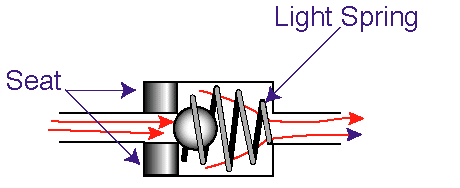 |
|||||
| Home | Research | For Teachers | HISTORY Level 1 Level 2 Level 3 |
PRINCIPLES Level 1 Level 2 Level 3 |
CAREER Level 1 Level 2 Level 3 |
| Gallery | Hot Links | What's New! | |||
| Web Administration and Tools | |||||
 |
|||||
| Home | Research | For Teachers | HISTORY Level 1 Level 2 Level 3 |
PRINCIPLES Level 1 Level 2 Level 3 |
CAREER Level 1 Level 2 Level 3 |
| Gallery | Hot Links | What's New! | |||
| Web Administration and Tools | |||||
![]()
Check Valves are hydraulic devices which permit flow of fluid in one direction only.

Flap type - this type of check valve is not used in hydraulics

Ball Type – Too heavy and has too much inertia to move

Poppet type valve is the preferred type that is used in hydraulics now. The front of the poppet (left side of the picture above) sits snugly on the hard seat (darker shaded areas on the left side). The poppet works on the following principle. When high pressure fluid (with pressure P1 ) comes in on the left, it forces the poppet open. Since P1>P2 , the force on the left side of the poppet (F1) is greater than the force due to the spring (F2 ) and is just enough to open the poppet. But, when flow stops, or there is a high pressure flow from the right side of the poppet, then P2>P1 and the pressure forces the poppet against the valve seat, closing off the opening. Thus the fluid is allowed to flow through in one direction only.
Check valves are designed so as not to tolerate leakage. The purpose of the light
spring is only to keep the poppet on the seat. The following Poppet type valve is used in
submarines.

Most manufacturers use sharp-edged, very hard seats and soft, maybe plastic, poppets. Parallel seats are very good except that they are too prone to trapping contaminants between the seat and the poppet.
Send all comments to ![]() aeromaster@eng.fiu.edu
aeromaster@eng.fiu.edu
© 1995-98 ALLSTAR Network. All rights reserved worldwide.
Updated: February 23, 1999